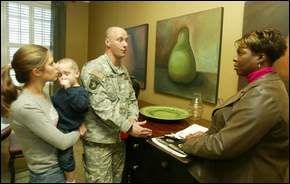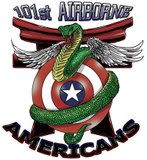Program guides wounded warriors to better options
Program guides wounded warriors to better options
'AW2' helps injured soldiers navigate Army system
By CHANTAL ESCOTO
The Leaf-Chronicle
Staff Sgt. David Jacks is hoping for a full recovery after an improvised explosive device left his arm partially paralyzed.
The 4th Brigade soldier was allowed to remain in Iraq on limited duty after the Dec. 29, 2005, attack in East Baghdad. But he's a little unsure of what the future holds.
"I'm just trying to figure out my options," said Jacks, who has served in the military for 18 years, and would like to retire but doesn't know if the Army will allow him to with his disability. "I got to return with my unit, and I'm in the process of getting back into the medical system," said the 36-year-old soldier. He returned to Fort Campbell two weeks ago.
A program called the Army Wounded Warrior Program was developed to help soldiers like Jacks and others seeking information about their disabilities and injuries and military options. Dubbed "AW2," the program started in August because of the need to have a one-stop advocate help soldiers and their families navigate the Army system.
"I feel like it's helpful here at Fort Campbell," said Nancy Nall, a soldier and family management specialist with AW2.
She recently spoke to about a dozen injured soldiers and their families at the post's Fisher House to spell out what the program offers.
Personnel and pay issues, spouse employment and VA claims are just some ways where AW2 can step in to help while the soldier recovers.

Trauma life insurance
Nall also advises soldiers if they qualify for the Traumatic Servicemembers' Group Life Insurance. The insurance was approved by Congress in 2005 as a rider under the Servicemembers' Group Life Insurance. It provides payment between $25,000 and $100,000 to any uniformed service member who suffers a traumatic injury resulting in certain severe losses.
The qualifying criteria include loss of eyesight, loss of limb, paralysis, severe burns, permanent disfigurement, multiple surgeries and prolonged hospital stays.
The money is not intended to be a replacement for a regular income or VA disability payments, but to get families through a temporary tough financial time.
"It lets them maintain their standard of living while the soldier is injured," she said.
Another stipulation of the TSGLI is if the debilitating injury happened after Dec. 1, 2005, it does not have to be combat-related.
That's good news for a fellow soldier of Spc. Bryan T. Price. Price, 25, said his comrade became paralyzed after breaking his neck during a swimming accident. Price — who himself is partially paralyzed from the waist down because of shrapnel lodged in his back from a June 20 IED explosion — said he already received the maximum TSGLI payment.
The money will help care for his wife, Melissa, and 10-month-old daughter, Ashlynn. Besides his family, his next priority is to fully use his legs again. He has worked up to getting around on a walker in just six months.
"I probably had 20 doctors tell me I wouldn't walk again, but I'm getting better," Price said.
Chantal Escoto covers military affairs and can be reached by telephone at 245-0216 or by e-mail at chantalescoto@theleafchronicle.com.









3 Comments:
This is a great article. I wish they had one of these at every Army base across the country.
great blog keep up the good work.
I hope he heals quick and god bless him and that program!!
Post a Comment
<< Home